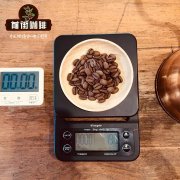Introduction of common fermentation treatment methods of coffee beans differences in flavor characteristics of coffee treated with sun, water washing and honey
The three most common fermentation methods of coffee beans

The word "fermentation" in life is often reminiscent of flour making cakes, Youtiao, steamed buns, steamed buns, or moldy food products. Fermentation has been so widely used in our daily life that we enjoy a wide variety of delicious fermented food. Huizhou hairy tofu, French wine, homemade pickled radish, northeast sauerkraut pork, canned Swedish herring, everyone knows it's fermented.
But in English, Fermentation is derived from the Latin fervere, which originally means "tumbling". It describes the phenomenon that yeast foams slightly or violently resembles boiling when yeast acts on grape juice or wort.
The three most common fermentation methods of coffee beans
The fermentation of beer
There is no doubt that beer is produced by fermentation, and the best-known formula for the fermentation of alcohol is that sugars produce alcohol and carbon dioxide by yeast. But in fact, the fermentation of beer is much more than alcohol. All kinds of flavors that people like and dislike need to be precisely controlled by the fermentation environment and state in order to produce more good flavors and less bad flavors.
Whether making noodles or making wine, it depends on the life activities of microorganisms under aerobic or anaerobic conditions to prepare microbial bacteria themselves, or their direct metabolites or secondary metabolites.
Interestingly, in the process of beer fermentation, the late yeast is still crying for food, at this time the fermentable sugar may have been exhausted, a variety of fermentation metabolites by-products will become yeast food.
Yeast that works like a beast in beer
At this time, winemakers control the bad taste to be eaten more, and the good taste to be eaten less, which becomes subtraction from addition. This is the main reason why beer needs ripening and diacetyl reduction, and some bottled beers taste better after a long time, because the bad taste is getting less and less, and the quality of the wine becomes clearer and cleaner.
The fermentation of coffee
Different biological changes take place in the natural fermentation of coffee. Yeast produces enzymes and lactic acid bacteria decompose the sugar in coffee pectin. Lipids, proteins and acids in sugars are degraded and converted into alkyd (alcohol acidic acids). The smell, color and pH of coffee will change, and so will the pectin composition of coffee.
The core of treatment is fermentation.
In the process of fermentation, different substances are involved (coffee peel, coffee pulp, coffee pectin, bacteria species, bacteria distribution), different environments (water and water, oxygen and oxygen, PH environment, etc.). Different drying methods and processes (container material, natural sun, drying equipment, turning times, etc.), resulting in different post-processing flavor and taste.
The basic process of coffee is coffee planting-> raw bean treatment-> cooked bean roasting-> coffee brewing. However, in this process of raw bean treatment, all kinds of treatment methods are inextricably related to fermentation.
There are many fermentation methods, two of which require special attention: dry fermentation (dry fermentation) and wet fermentation (wet fermentation).
Dry fermentation Dry fermentation and its Flavor characteristics
Put the coffee with pulp and pectin on the surface in a concrete fermentation tank. Dry fermentation helps to improve the sweetness, chocolate and fruit flavor characteristics of the coffee. Dry fermentation is also accompanied by a challenge: controlling the temperature. Temperature affects the degree of fermentation, poor temperature control will have a negative impact on the consistency and flavor of coffee.
Wet fermentation Wet fermentation and its Flavor characteristics
Wet fermentation is sometimes called "double washing" double washed, "double fermentation" double fermented, "Kenyan water washing", and so on. This treatment is common in East Africa and can improve purity.
"after removing the peel and pulp of the coffee, we soak the coffee with parchment in water, which prolongs the fermentation time and produces a soft mellow thickness, complex acidity, and more subtle flavor.
Natural Process
Solarization method
Sun-Dried or Natural full sun exposure
As the name implies, sun-drying means that coffee fruits are completely dried by the sun.
Sun treatment is the simplest and cheapest traditional method in coffee bean processing. During processing, the harvested fruit should be spread on cement floor, brick floor or straw mat, viaduct bed and sun bed should be put in the sun, and rake is often used to prevent fermentation. If it rains or the temperature drops, the fruit must be covered to prevent damage.
After about treatment, the water content of each fruit will decrease to about 12%.
Honey Process
Honey treatment method
Honey (Miel) Processing honey treatment
Peel and pulp are removed by machine and pectin is retained for sun drying.
White Honey honey 80% mae 90% pectin was removed.
Yellow Honey yellow honey retains 50% pectin and has no fermentation. Receive the most light and dry for about 8 days
Red Honey red honey removes 25% pectin and has no fermentation. The sun lasts about 12 days, and a sunshade may also be used in the process.
Black Honey black honey basically retains all pectin and dries at a slightly higher temperature at low altitude. It is covered with slight fermentation in the first 24 hours, and then the drying process is transferred to an African drying bed for drying.
Gold Honey Jinmi basically retains all pectin, drying at low temperature at high altitude and prolonging the drying time.
In individual estates, the treatment of individual batches will be different.
Washed process
Washing method
Washed: semi-washed Semi-Wash and full-washed Full-wash.
The traditional water treatment is used to treat freshly picked coffee beans. The flesh of the coffee is peeled off immediately, and the shorter the interval is, the better. Then the coffee beans are soaked in water for 12-36 hours. This process softens its skin so that it can be washed off easily. Coffee beans are then sorted and dried in the sun.
The final product of both methods is: raw coffee beans with parchment.
Main difference: remove pectin directly by machine or through fermentation tank to remove pectin layer.
Semi-washed: after peeling and pulping, the coffee fruit does not go through the fermentation tank, but through a special pectin removal machine to remove pectin.
Full water washing: after removing the peel and pulp of the coffee fruit, enter the fermentation tank and remove the pectin layer after 1-2 days of fermentation (the time varies according to the temperature and humidity of the site). There are different ways of enzyme and no enzyme.
Ethiopian water washing: belongs to the traditional wet fermentation treatment. The coffee cherries are washed, peeled and introduced into the fermentation tank to ferment with water below the water level of the fruit, rinse, soak in a clean sink for one night, and dry in the greenhouse the next day. Fermentation with water for up to three days, need a lot of clean water, need to monitor the process of PH should not be lower than four or five.
Kenyan washing: the famous K72 mode. Coffee cherry wash, peel, dry fermentation 24 hours, wash, dry fermentation again 24 hours, wash, dry fermentation again 24 hours, cycle treatment, reach 72 hours fermentation, after washing, soak the sink for one night, and start drying the next day.
Important Notice :
前街咖啡 FrontStreet Coffee has moved to new addredd:
FrontStreet Coffee Address: 315,Donghua East Road,GuangZhou
Tel:020 38364473
- Prev

Interpretation of common coffee types and characteristics, behind-the-scenes allusions, history and definition of six major coffee types
Professional coffee knowledge exchange more coffee bean information Please follow the coffee workshop (Wechat official account cafe_style). You who drink coffee every day know their names like the back of your hand, but how much do you know about the allusions, history and definitions behind them? When I eat out, I don't have a clue about the names of many dishes on the menu. In fact, each dish has its own unique local characteristics and history. Instead of asking the waiter, no.
- Next

What coffee varieties do Starbucks have? how do Starbucks order coffee to make a normal classification of Starbucks coffee?
Professional coffee knowledge exchange more coffee bean information Please follow the coffee workshop (Wechat official account cafe_style) mention coffee, people will think of Starbucks, the world's largest coffee chain founded in 1971. Starbucks offers a variety of coffee drinks for people with different tastes. But for friends who are not coffee people, it may be good for coffee.
Related
- Detailed explanation of Jadeite planting Land in Panamanian Jadeite Manor introduction to the grading system of Jadeite competitive bidding, Red bid, Green bid and Rose Summer
- Story of Coffee planting in Brenka region of Costa Rica Stonehenge Manor anaerobic heavy honey treatment of flavor mouth
- What's on the barrel of Blue Mountain Coffee beans?
- Can American coffee also pull flowers? How to use hot American style to pull out a good-looking pattern?
- Can you make a cold extract with coffee beans? What is the right proportion for cold-extracted coffee formula?
- Indonesian PWN Gold Mandrine Coffee Origin Features Flavor How to Chong? Mandolin coffee is American.
- A brief introduction to the flavor characteristics of Brazilian yellow bourbon coffee beans
- What is the effect of different water quality on the flavor of cold-extracted coffee? What kind of water is best for brewing coffee?
- Why do you think of Rose Summer whenever you mention Panamanian coffee?
- Introduction to the characteristics of authentic blue mountain coffee bean producing areas? What is the CIB Coffee Authority in Jamaica?

